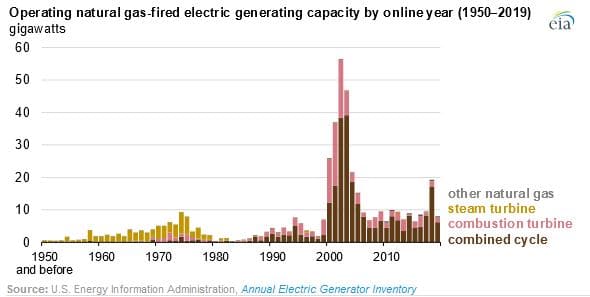Natural Gas Generators Accounted for 43 Percent of U.S. Electricity Generating Capacity in 2019: EIA

Natural gas-fired generators accounted for 43 percent of operating U.S. power generating capacity in 2019, according to an Oct. 16 report from the U.S. Energy Information Administration based on the agency’s annual survey of electric generators. They provided 39 percent of generation last year, more than any other source.
Most of the capacity added in recent decades uses combined-cycle technology, which outpaced coal-fired generators in 2018 to become the dominant power generating technology in the nation. Combined-cycle systems known for their higher efficiency compared to steam or combustion turbines alone. Further, systems installed more recently operate even more efficiently compared those that were built more than a decade ago. Thanks to the enhanced efficiency, combined-cycle generators provide 85 percent of electricity by consuming 80 percent of the natural gas used to generate electric power.
Texas, Florida, and California, which consumed the most electricity in 2019, have more than 35 gigawatts of natural gas-fired capacity each. In many states, combined-cycle technology dominates gas-fired plants. However, in New York 44 percent of gas capacity is steam turbines, and in Illinois 67 percent is combustion turbines.
EnerKnol Pulses like this one are powered by the EnerKnol Platform—the first comprehensive database for real-time energy policy tracking. Sign up for a free trial below for access to key regulatory data and deep industry insights across the energy spectrum.
ACCESS FREE TRIAL